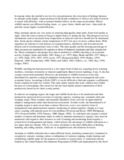| dc.description.abstract | In regions where the rainfall is too low for crop production, the conversion of herbage biomass by animals yields highly valued products In the hostile conditions of Africa's dry lands livestock is reared with difficulty, with occasional harmful effects on the range environment. Mixed wildlife species use different feeding strata - i.e. grass, fortes, shrubs and trees - than cattle do, and thus secure higher overall efficiency.
Many antelope species are very astute in selecting high-quality plant parts. Some feed mainly at night, when the water content of forage is higher than it is during the day. Physiological survival mechanisms such as increased body temperature or reduced water loss should also be mentioned here. Some species tolerate a body temperature of 45°C for up to six hours without harm. Wild ungulates are tolerant of such diseases as trypanosomiasis, theileriosis and foot-and-mouth disease and of external parasites such as ticks. The meat quality and the dressing percentage of their carcasses are reported to be superior to those of domestic ruminants and they contain less fat. These comparative advantages have drawn attention to wildlife ranching as an economic activity (Ledger, Sachs and Smith, 1967; King et al., 1975; King, Heath and Hill, 1977; King et al., 1978; Field, 1972, 1975, 1979; Lewis, 1977; Hoogestein-Reul, 1979; Walker, 1979; Hopcraft, 1980; Sommerlatte, 1990; Talbot and Talbot, 1963; Talbot et al., 1965; Kay, 1970; Ledger, 1983).
Wildlife ranching has been perceived as a low-input form of land use, requiring fewer watering facilities, veterinary treatments or mineral supplements than livestock ranching, if any. It also has a range conservation potential. However, the potential of wildlife resources is not only determined by superior ecological adaptation mechanisms, but also by managerial and socio-economic forces. According to Kyle (1987), it can be difficult to find and organize a sufficiently broad commercial outlet for venison. The same author reports that some schemes have failed because of overcropping. One reason for this has been highly tentative predictions of herd productivity based on too short a study period.
In order to set cropping targets, the range and wildlife herds have to be monitored and their productivity narrowed down in terms of carrying capacity, stocking rate, sustained yield and cropping target. These complex and mutually dependent issues can only be approached by adaptive management rather than theoretical assessment. In other words, the determination of cropping targets is more an art than a science. However, even a very intuitive form of management (and administration) requires monitoring of animal numbers. Simple as it may seem, counting wild animals poses its own problems (Overtop and Davis, 1969; Eltringham, 1973; Norton-Griffith, 1978; Sinnary, 1988; Magin, 1989). As wild herds also require a critical number of mature and dominant males in order to maintain reproductive capacity, they must be monitored with regard to their structure as well. Counting and monitoring herds requires a certain level of management and inputs, which reduces the advantage of wildlife utilization as a low-input land-use scheme. This is, of course, all related to the sheer difficulties of herding, handling and culling animals, which are so straightforward with domestic livestock.
Attempts at wildlife utilization have taken different forms, including commercial, communal or cooperative ventures, running various combinations of venison cropping, trophy hunting and establishing wildlife parks for the purpose of tourism or conservation. A communal scheme funded by the United Nations Development Programme (UNDP) and implemented by the Food and Agriculture Organization of the United Nations (FAO) in Zambia was the Luangwa Valley Conservation and Development Project. These same agencies carried out a wildlife management project in the Kajiado district of Kenya, where cropping activities came to a halt in 1976 when the government banned all hunting of wildlife. In Zimbabwe (Style, 1990) and Namibia (Berry, 1990), wildlife ranching has become a widespread enterprise of mostly commercial ranches backed by national wildlife departments. | en_US |

